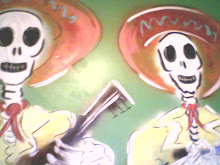THE TEXAS CHAIN SAW MASSACRE (Hooper, 1974)

The Texas Chain Saw Massacre, for me, is the end-all, be-all of horror. Since my initial viewing of it, I've seen movies that have disturbed me on deeper levels and disgusted me and made my skin crawl, but nothing has stuck with me like this film. It reverberates on a level that I Spit On Your Grave and the Guinea Pig films never do. Despite its rather notorious reputation, it's actually an exercise in restraint. Most of the violence occurs off-screen or is implied. There is no nudity, little in the way of explicit gore, and what violence is seen is really sort of tame, especially in light of what's come since.
And in spite of all this, it is still the pinnacle of relentless terror in American cinema.
This is the sort of film that divides people. You can lose friends by admitting that you enjoyed it, found pleasure in it. "Why watch that when there's so much violence in real life?" Well, the short answer is, violence doesn't go away by ignoring its existence. Rather, by depicting violence on screen, perhaps we're exorcising some demons. Maybe this is release, catharsis, not at all unlike the Greek tragedies. Director Tobe Hooper has stated that the film is a reaction to the Viet Nam War, to the images that were appearing on the television each and every night. Maybe this picture was his way of externalizing all of that, turning his rage and despair into art.
There are many who would (and do) argue that Chain Saw is not art at all. Those people are idiots. On a purely visceral level, the film is a masterpiece. There is craft to appreciate, certainly, but the craft is of such an extreme nature that it nearly makes it pointless. To dissect and analyze is almost beside the point, when there is simply so much happening on the surface. A large part of this is the utterly terrifying soundtrack, which sounds sort of like a noise rock band playing inside of an exumed corpse. Horrible squeals and shrieks and the wail of the saw form a wall of pure white noise. And that's not even taking into account the pre-credits opening montage, with the Hitchhiker's camera snapping away shots of the carnage his family has caused. The sound of the camera is eerie and haunting and will burn itself onto your memory. Phil has often said that you can simply listen to the sound of the film without an image and still be creeped out. This attention to deal on the soundtrack speaks to a deeper level of committment and craft than the average genre film. Texas Chain Saw isn't just a good horror film, it's a good film period. Haunting and relentless, to be sure, but why are these emotions any less relevant than happiness and joy?
To watch this movie is to concede to the darker side of things, to accept that maybe things won't always turn out right. Texas Chain Saw is one of the only movies to present a character in a wheelchair (Franklin) and make that character completely unlikeable. In this way, Franklin becomes believable and realistic (human), not some symbol for equality. Films rarely take that type of risk; perhaps only the late-90s masterpiece, Happiness, has come close since then. Franklin is bitter and depressed and angry and miserable to everyone around him and I wouldn't have him any other way. Realism is never sacrificed for the sake of a message. And reality is not pretty and bright. In the end, Sally survives, laughing, and Leatherface dances alone with his saw, but the sheen of bleakness never really subsides. All that the viewer can imagine is that Sally is a neurotic mess, holed up in a state hospital and filled with regret and repressed memories. The ending isn't happy, it's just a place where the film ends. She lives but it's impossible to think that she escapes with anything other than her life.
I tend to watch horror films for their societal relevance. My favorite genre pictures are those of George A. Romero, John Carpenter, Wes Craven, Takashi Miike, and, yes, Tobe Hooper, all of whom deal with deeper themes than what is simply happening on the screen. The point of this project, I think, is going to be to see simply what I can draw some these pictures. Thirty(-one) days of night, of mayhem, of blood and gore and trying to put it all together into some sort of larger context. Maybe it's about trying to find some kind of meaning, an attempt to glean meaning from the seemingly meaningless. (Or maybe it's just fun to watch a year's worth of mayhem and gore in a single month.)
Labels: 31


0 Comments:
Post a Comment
<< Home